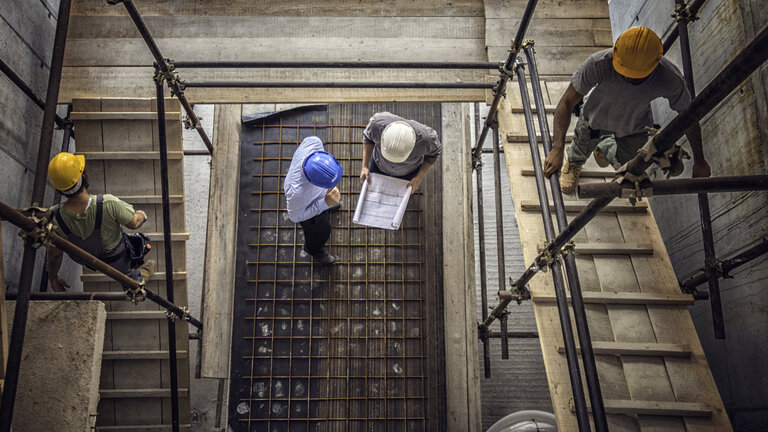Dusseldorf, Germany, April 19, 2021. The German government intends to use a total of EUR 130 billion to stimulate the economy following the pandemic-related slump. It is not only the private sector that will benefit from this corona stimulus package. More than EUR 2.5 billion is available to local authorities for the energy-efficient renovation of public buildings alone. There is also further funding for climate adaptation measures. The funds are therefore not only reducing the many years of backlog in renovation work but are also helping to reach the target of becoming carbon-neutral by 2050. Prioritizing investments wisely is anything but easy. Drees & Sommer SE, a Stuttgart-based consulting company specializing in construction and real estate, is advising cities such as Krefeld, Dusseldorf and Herne in this task.
Schools with leaking roofs, sports halls with shabby plumbing, or community centers with outdated heating systems: many public buildings suffer from a huge investment backlog due to tight municipal budgets. At the same time, renovation is urgently needed: Germany aims to become carbon-neutral by 2050. Since the building sector accounts for around 40 percent of energy consumption and greenhouse gases, net zero can only be achieved with a large-scale wave of renovation that includes municipal buildings. For many cities and municipalities, this is a major challenge because: ‘In many cases, local authorities and their decision-makers lack an overview of how to reduce the maintenance backlog – and how to develop CO2-reducing measures. To do this, the entire portfolio must be presented with a long term view, including prioritizing the investments. To get buildings carbon-neutral with minimal effort, energy upgrades can be combined with reduction of the renovation backlog. So, in order to improve the planning of real estate budgets and personnel requirements, we must first make a precise survey of the existing stock of buildings,’ said Karsten Eisenmann, Associate Partner at Drees & Sommer in Dusseldorf.’
The City of Krefeld Focuses on Strategic Analysis of Properties
A stock analysis of this nature includes a whole bundle of measures. As a Drees & Sommer project manager, Martin Wrobel’s work included advising the city of Krefeld on analyzing its real estate. A total of 475 buildings were scrutinized for this purpose. He explained: ‘We always hold a workshop at the beginning, to evaluate and determine the focus of the survey and to agree on the required data structure. On this basis, we develop a survey catalog together with the local authority, along with an assessment system.
A profile is then compiled for each building, comprising a detailed catalog of measures and a prioritization schedule. The highest priority is always given to safety aspects, such as fire prevention and road safety. All other repair and renovation work is ranked by urgency over a timeframe of several years. The data also provides information on potential CO2 savings at the individual building level as well as portfolio level.’
The data collected in this way represents a first step towards digital public building management, as it can be easily transferred to appropriate CAFM systems. CAFM (computer-aided facility management) helps to enhance both the added value as well as the transparency and safety of properties on a long-term basis. In short, systematic data collection provides the opportunity to derive strategic decision-making for individual buildings, clusters of buildings or the real estate portfolio.
In the case of Krefeld, this means that the city will have to invest around EUR 200 million in the medium term. Schools in particular are in urgent need of renovation, followed by sports halls. The analysis also shows that buildings constructed after the Second World War generate the most costs, at more than EUR 800 million.
Renovation Rate Below 1 Percent
This problem not only affects Krefeld. In Germany, around half of all residential buildings date from the period 1949 to 1990. These in turn are responsible for half of the total energy consumption. In addition, only about one in every hundred buildings is renovated each year. The German government’s economic stimulus package, in combination with subsidies and funding programs, is now intended to create incentives for a higher renovation rate. And the investments are paying off, as a look at the south of Germany shows. Completed in 2017, the city hall in Freiburg (in the German federal state of Baden-Württemberg) is regarded as the world’s first net plus energy public building. It produces energy from renewable sources, so it not only covers its own power needs, but also feeds surplus electricity into the grid. This means the building functions like a miniature power plant. While these surplus-energy properties can be implemented most quickly as new buildings, simple measures such as more efficient heating systems or better insulation provide huge potential for energy savings, even in existing buildings. In these cases, too, the sound basis for decision-making provided by a strategic property analysis does help.
In addition to Krefeld, cities in the German federal state of North Rhine-Westphalia (such as Dusseldorf and Herne) have also benefited from this special Drees & Sommer service, as have many other major cities such as Stuttgart, as well as other local authorities and companies throughout Germany. ‘Strategic property management makes maintenance and CO2-reducing renovation requirements transparent, plannable and therefore economically feasible,‘ summarized Karsten Eisenmann.
